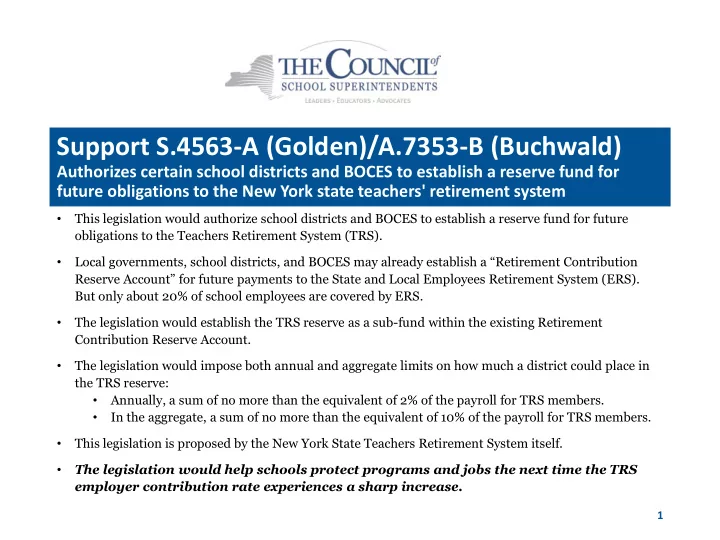

Support S.4563-A (Golden)/A.7353-B (Buchwald) Authorizes certain school districts and BOCES to establish a reserve fund for future obligations to the New York state teachers' retirement system • This legislation would authorize school districts and BOCES to establish a reserve fund for future obligations to the Teachers Retirement System (TRS). • Local governments, school districts, and BOCES may already establish a “Retirement Contribution Reserve Account” for future payments to the State and Local Employees Retirement System (ERS). But only about 20% of school employees are covered by ERS. The legislation would establish the TRS reserve as a sub-fund within the existing Retirement • Contribution Reserve Account. • The legislation would impose both annual and aggregate limits on how much a district could place in the TRS reserve: • Annually, a sum of no more than the equivalent of 2% of the payroll for TRS members. • In the aggregate, a sum of no more than the equivalent of 10% of the payroll for TRS members. • This legislation is proposed by the New York State Teachers Retirement System itself. The legislation would help schools protect programs and jobs the next time the TRS • employer contribution rate experiences a sharp increase. 1
Why do schools need a TRS reserve? The mandated employer District Costs Fluctuate 84% of TRS revenue comes from contribution rate had been investment income. going down. A large factor in calculating the Employer Contribution Rate is the New York State Teachers Retirement System average rate of return earned by the Employer Contribution Rate system’s investments, calculated using a 20% 17.53% rolling 5-year average. 16.25% 18% 16% 13.26% 11.84% Two years which produced great returns 14% 11.72% 11.11% 9.80%10.63% 12% 8.73% 7.63% 6.19% 8.62% will be dropping out of the 5-year 10% 8% average. 6% 4% Market Value of 2% 0% TRS Fiscal Year Returns 2012-13 13.7% 2013-14 18.2% Payroll Year 2014-15 5.2% 2015-16 2.3% SOURCE: Compiled by the Council from NYS Teachers Retirement 2016-17 12.5% System documents. 2017-18 ? 2
A TR TRS rese serv rve would ld help lp sc schools ls protect programs and jo jobs th the next xt tim time th there is is a sh sharp inc increase in in th the mandated contr trib ibutio ion rate In 3 recent years, increases in TRS costs exceeded or approached the change in total school spending – schools had to cut other services to absorb TRS increases. Change in Statewide TRS Costs $2,000,000,000 Change in Total School Spending $1,500,000,000 Change in Cost $1,000,000,000 $500,000,000 $0 -$500,000,000 -$1,000,000,000 School Year/Payroll Year Employer 8.60% 8.73% 7.63% 6.19% 8.62% 11.11% 11.84% 16.25% 17.53% 13.26% Contribution Rate SOURCE: Compiled by the Council from Office of the State Comptroller school district financial data and NYS Teachers Retirement Administrative Bulletins. Figures do not include New York City, which has its own teachers retirement system. Data for the 2016-17 school year will be added as soon as it becomes available. 3
Giv ive school l dis istricts the tools to manage fin inancial uncertain inty. • Municipalities may already use a reserve to set aside funds for all their pension obligations. Schools may do so only on behalf of employees covered by the Employees Retirement System (ERS), not the 80% or so of their workforce in TRS. • Municipalities also have no percentage limit on how much they may place in an unrestricted fund balance; school districts are limited to 4% of budget. The Government Finance Officers Association recommends 10% for school districts. • These tighter restrictions may have made more sense in earlier times, when school revenues were more stable – before state revenues became so tied to gyrations on Wall Street and before larger tax certioraris (assessment challenges) became more common. • School districts have financial reporting and accountability requirements beyond those required of local governments. Districts outside the “Big 5” cities must submit their operating budgets for voter approval, must obtain 60% voter approval to over-ride their property tax cap, and may not increase their tax levy at all if voter approval is not obtained. • Accountability requirements for school districts around reserves were expanded by legislation enacted in 2016 – Chapter 514 of the Laws of 2016; S.5795-A (Marcellino)/A.7675-A (Buchwald). • A TRS reserve would help schools preserve programs and jobs the next time the employer contribution rate surges. 4
Recommend
More recommend